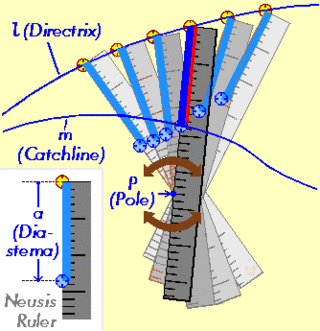
In geometry and algebra, a real number is constructible if and only if, given a line segment of unit length, a line segment of length can be constructed with compass and straightedge in a finite number of steps. Equivalently, is constructible if and only if there is a closed-form expression for using only integers and the operations for addition, subtraction, multiplication, division, and square roots.

A prime number is a natural number greater than 1 that is not a product of two smaller natural numbers. A natural number greater than 1 that is not prime is called a composite number. For example, 5 is prime because the only ways of writing it as a product, 1 × 5 or 5 × 1, involve 5 itself. However, 4 is composite because it is a product (2 × 2) in which both numbers are smaller than 4. Primes are central in number theory because of the fundamental theorem of arithmetic: every natural number greater than 1 is either a prime itself or can be factorized as a product of primes that is unique up to their order.

In geometry, straightedge-and-compass construction – also known as ruler-and-compass construction, Euclidean construction, or classical construction – is the construction of lengths, angles, and other geometric figures using only an idealized ruler and a pair of compasses.
2 (two) is a number, numeral and digit. It is the natural number following 1 and preceding 3. It is the smallest and only even prime number. Because it forms the basis of a duality, it has religious and spiritual significance in many cultures.

Angle trisection is a classical problem of straightedge and compass construction of ancient Greek mathematics. It concerns construction of an angle equal to one third of a given arbitrary angle, using only two tools: an unmarked straightedge and a compass.
In mathematics, a Fermat number, named after Pierre de Fermat, the first known to have studied them, is a positive integer of the form
11 (eleven) is the natural number following 10 and preceding 12. It is the first repdigit. In English, it is the smallest positive integer whose name has three syllables.
The Huzita–Justin axioms or Huzita–Hatori axioms are a set of rules related to the mathematical principles of origami, describing the operations that can be made when folding a piece of paper. The axioms assume that the operations are completed on a plane, and that all folds are linear. These are not a minimal set of axioms but rather the complete set of possible single folds.
In Euclidean geometry, a regular polygon is a polygon that is direct equiangular and equilateral. Regular polygons may be either convex, star or skew. In the limit, a sequence of regular polygons with an increasing number of sides approximates a circle, if the perimeter or area is fixed, or a regular apeirogon, if the edge length is fixed.

In geometry, a heptagon or septagon is a seven-sided polygon or 7-gon.
31 (thirty-one) is the natural number following 30 and preceding 32. It is a prime number.

In mathematics, a constructible polygon is a regular polygon that can be constructed with compass and straightedge. For example, a regular pentagon is constructible with compass and straightedge while a regular heptagon is not. There are infinitely many constructible polygons, but only 31 with an odd number of sides are known.

In geometry, a hendecagon or 11-gon is an eleven-sided polygon.

In geometry, a tridecagon or triskaidecagon or 13-gon is a thirteen-sided polygon.

In geometry, the neusis is a geometric construction method that was used in antiquity by Greek mathematicians.
The number 4,294,967,295 is a whole number equal to 232 − 1. It is a perfect totient number, meaning it is equal to the sum of its iterated totients. It follows 4,294,967,294 and precedes 4,294,967,296. It has a factorization of .
In number theory, a cyclotomic field is a number field obtained by adjoining a complex root of unity to Q, the field of rational numbers.

In geometry, an icositrigon or 23-gon is a 23-sided polygon. The icositrigon has the distinction of being the smallest regular polygon that is not neusis constructible.
A Proth number is a natural number N of the form where k and n are positive integers, k is odd and . A Proth prime is a Proth number that is prime. They are named after the French mathematician François Proth. The first few Proth primes are
Geometric Origami is a book on the mathematics of paper folding, focusing on the ability to simulate and extend classical straightedge and compass constructions using origami. It was written by Austrian mathematician Robert Geretschläger and published by Arbelos Publishing in 2008. The Basic Library List Committee of the Mathematical Association of America has suggested its inclusion in undergraduate mathematics libraries.
































